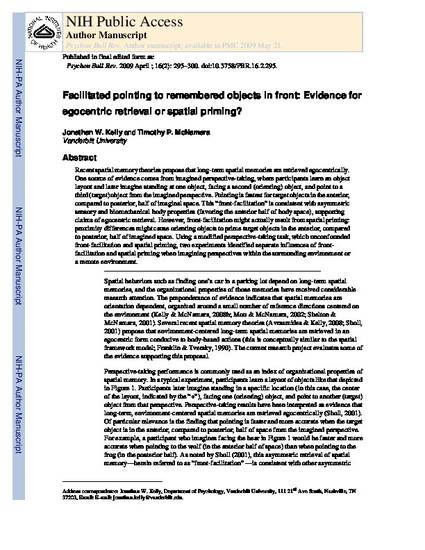
Article
Individual differences in using geometric and featural cues to maintain spatial orientation: Cue quantity and cue ambiguity are more important than cue type
Psychonomic Bulletin & Review
(2009)
Abstract
Two experiments explored the role of environmental cues in maintaining spatial orientation (sense of selflocation and direction) during locomotion. Of particular interest was the importance of geometric cues (provided by environmental surfaces) and featural cues (nongeometric properties provided by striped walls) in maintaining spatial orientation. Participants performed a spatial updating task within virtual environments containing geometric or featural cues that were ambiguous or unambiguous indicators of self-location and direction. Cue type (geometric or featural) did not affect performance, but the number and ambiguity of environmental cues did. Gender differences, interpreted as a proxy for individual differences in spatial ability and/or experience, highlight the interaction between cue quantity and ambiguity. When environmental cues were ambiguous, men stayed oriented with either one or two cues, whereas women stayed oriented only with two. When environmental cues were unambiguous, women stayed oriented with one cue.
Disciplines
Publication Date
2009
DOI
10.3758/PBR.16.1.176
Publisher Statement
This is a manuscript of an article published as Kelly, J.W., McNamara, T.P., Bodenheimer, B., Carr, T.H. & Rieser, J.J. (2009). Individual differences in using geometric and featural cues to maintain spatial orientation: Cue quantity and cue ambiguity are more important than cue type. Psychonomic Bulletin & Review, 16(1), 176 -181. doi:10.3758/PBR.16.1.176. Posted with permission.
Citation Information
Jonathan W. Kelly, Timothy P. McNamara, Bobby Boddenheimer, Thomas H. Carr, et al.. "Individual differences in using geometric and featural cues to maintain spatial orientation: Cue quantity and cue ambiguity are more important than cue type" Psychonomic Bulletin & Review Vol. 16 Iss. 1 (2009) p. 176 - 181 Available at: http://works.bepress.com/jonathan_kelly/23/
